Fee Fi Foe Film: Indiana Defense

Previously: Ace did the offense.
pretty good, still indiana
Last year’s heavy-offense, no-defense #CHAOSTEAM was hella fun for everybody not responsible for Indiana’s defense. New defensive coordinator Tom Allen is a Hugh Freeze assistant who was about to get the Auburn DC job if Muschamp turned it down. It seemed like a good hire. It’s been more like a Don Brown good hire.
Indiana pork famers aren’t investing in nets just yet. Since poking into the Top 25 after Ohio State, three rough outings against the far east of the Big Ten East dropped Indiana’s defensive S&P to a just 46th. That’s still ahead of the offense, which goes against everything you ever thought you knew about Indiana. This I had to see.
I started out with last week’s PSU game then switched to Michigan State (from way back on October 1st) because Indiana’s been playing all spreads since. If you squint you can pass off the rampantly holding State OL (it was even more ridiculous than against Michigan) as Michigan’s comparative OL competency, and Price as a poor man’s Butt, and wobbly Tyler O’Connor as John O’Korn in his first game, and early October rain for November rain.
What I saw is what you might expect from Don Brown if you gave him four sticks of bubble gum, various old truck tires, and an unused set of wedding knives. Allen’s 4-2-5 defense is a jalopy that’s marvelous because it knows what it is. They keep their linebackers clean and aggressive, don’t ask their DBs to cover very long, and solve any and all problems with aggression. Until that doesn’t work, whence Indiana.
Personnel: My diagram:
The DL has a lot of rotation: seven defensive lineman have over 200 snaps this year (an 11th is at 94) according to PFF’s tracking, and the last guy on that list leads the team in QB hurries. Robinson and Hoff are space-eaters, Green is the beast; he will often slide down to NT. Off the bench, Dougherty and McCray can line up inside or out; the former is a run-stuffing specialist and the latter is an excellent stunt pass rusher. Pass rush from the WDE position has been an issue: Gooch is just a guy, and Sykes is a big downgrade when Gooch comes out—nearly all of Indiana’s pass rush comes from blitzing linebackers and stunts.
The back seven mostly stay on the field. Former starter Chase Dutra got pushed out by SS Tony Fields, who still has some issues but isn’t a gaping hole in deep coverage; Dutra still rotates in plenty as a run-stopping/red zone option. Fant and Riggins will play nearly every down. The linebacker hanging off the edge is their version of a hybrid space player, true freshman Marcelino Ball, whom I’ll discuss further down.
[Hit THE JUMP for the rest of the breakdown]
Base Set? A 4-2-5 that’s spiritually more like a 3-4. I pulled this from the MSU tape to show you what it tends to look like against how Michigan lines up:
The “husky” is a hybrid space player who for Indiana leans toward the blitzy linebacker end of the scale. As Michigan fans we’re used to 4-2-5 defenses we face being those MSU/OSU/Virginia Tech quarters things that make the WLB a coverage LB. This is more akin in spirit to “true” 4-2-5s like Michigan’s 4-3, where the SAM is an attack piece and the WLB/MLB are mostly interchangeable light linebackers.
They make it work by shooting four down linemen into offensive linemen (as opposed to gaps) every play, making it really hard to ever get more than one free-releasing OL to the second level. That leaves a free-hitter, usually Scales, to read and chop it down. Like the DTs, the strongside end plays heavy, only going into the backfield if he’s pushing an offensive lineman (and a tight end too if he’s in the way) back there with him. They don’t really two-gap—they control one shoulder and play to spill to the other. More often than not they align the NT in a “2i” (guard’s inside shoulder), happy to let the center release into two rather aggressive linebackers while the rest of his linemates are getting squeezed into the backfield. A typical run play ends up looking thusly:
For passing downs they have a 3-3-5 that’s similar to the one Don Brown installed in Ann Arbor:
For that they’ll bring at least 4 guys and play quarters or man (hard to tell sometimes) behind it with some Cover 3 mixed in.
Man or zone coverage? Quarters that, like MSU, plays like man, with the CBs up in your grillz and daring you to escape downfield before a blitzballs linebacker eats your quarterback. Look at the CBs here, then look at the clock:
They did back off next down…and brought six.
Another thing Indiana has in common with vintage Narduzzi-era MSU are safeties stepping down aggressively. This is usually the strong side guy. Like State versus trips they’ll run split coverages, with the field side playing Quarters and the boundary CB in man so the safety to his side can drift into a deep zone. I think they trust the freshman boundary CB more than they do Fant, and the offense largely agreed.
They share a third annoying Narduzzism: defensive holding, though unlike MSU it’s most prevalent inside. I saw a ton of Hoosiers grabbing receivers when they were about to get crossed, to the degree where I wonder if it’s a coaching point. As Michigan can attest lately, the thing about leaving just one guy to cover the tackle box is you’re living and dying on his athleticism. Other than Scales (and he’s on the edge) their LBs and safeties don’t have the speed or agility to catch up if a crossing route gets in front of them. Their answer in this game was to just grab whoever tries to get in front of them.
Pressure: GERG or Greg? GREG-Plus and well into Don Brown “Solve your problems with aggression” territory. Running power risks meeting a linebacker in your gap before the guard can arrive. Long passes demand dodging various sharp instruments. The average down got 4.5 attackers, often six and never less than four. If a linebacker finds himself covering nobody, he’ll shoot upfield to force the issue rather than sink into coverage. This results in passes over that guy’s head, sure, but also cuts down on the amount of time the coverage is out there against superior athletes (i.e. everybody).
Hybrid space player Marcelino Ball is a mediocre linebacker/defensive back and very good edge weapon, so they’ll often use him like a super-small DE. Scales and Oliver are coming about 1/3rd of the time, and both are rather slippery through a gap. They’re all very knife-like. Speight’s size and pocket presence would have been nice.
On long downs, 3-3-5 or no, they also stunt a lot. They’ve already got DTs regularly pushing guards upfield so looping another guy into a gap inside works within their system.
Dangerman: By far their best player is weakside linebacker Tegray Scales, who is turning out to be exactly what we hoped James Ross would become. Scales recorded 110 tackles and 10 TFLs the last two years while only starting once, which is a bit baffling given that level of production. It’s not hard to guess they were trying to put weight on him. Scales is listed at 6’0” and a still clearly generous 230, but reads the play very quickly and gets upfield so fast that his size barely matters. Here he reads run, comes down at the hand-off, forms up in the hole, and gives physics a one-yard participation trophy:
Here he shoots a gap and whizzes by the lead blocker, creating a TFL.
Here he zips past #75 so fast on a QB power dude forgets to block anyone:
Indiana’s new-look front keeps Scales clean, and the results speak for themselves.
Keeping Scales away from your running game is a tough task with four OL occupied, and if you try to block him with the fifth you’re leaving his not-as-good but still quite awesome buddy Marcus Oliver alone.
Oliver is a thicker version of Scales. Scales has 85 tackles, 11 TFLs and three sacks this season, with a vindicatingly large PFF grade of +17.8. Oliver (+9.9) has 67 tackles, 7.5 TFLs and three sacks himself while taking on the center far more often. The big difference is in pass pro: Scales adds adequate coverage (+1.3 to PFF); Oliver (-5.7) is below average at this. Both are regular offenders of those crossing holds I talked about.
Both linebackers use the luxury provided by press coverage to react hard to run looks, play-action be damned. When they do blitz they generate all sorts of havoc since either is a far more dangerous tackler than the condensed balls of protein in front of them.
None of those DL really stand out, but if I’d have to pick a favorite it’s the DT, Ralph Green III, who’s got a +7.2 run defense grade and some ludicrous upfield burst.
He’s also the most likely to get out of his lane, however, so he didn’t get a star.
I didn’t know what to do with Rashard Fant, who’s got a +9.3 to PFF (a third of that is run d) and the somewhat dubious honor the last two years of leading the Big Ten in passes defended. He was up and down enough in this game that I would have given him the turquoise circle if PFF had given him as big of a minus. But +9 is a very good grade for a cornerback. My guess at that is the Quarters mistakes he was making in this game are gone six weeks later, while the gaping hole in his game—turning around is a rather long, James Rogersian process—is something none of Indiana’s opponents are particularly good at attacking. As you saw in the opening video, Fant’s top speed is good enough to catch R.J. Shelton, but the acceleration and agility are wanting.
I was more impressed with his opposite, true freshman A’Shon Riggins, who emerged from behind last year’s starter Andre Brown (who is apparently taking a medshirt year) and next guy/nickel Tyler Green. Riggins was regularly left on an island on the boundary side, and gave up only a few comeback routes. He’s got a –1.7 on the year.
¯\_(ツ)_/¯.
Special Teams, quickly: PFF’s numbers for special teams are always hilarious, but punter Joseph Gedeon’s –22.2 was partially earned: he’s netting just 37.6 yards and over half of his punts are returnable.
Not that Indiana will punt unless they have to. Michigan will be punting to slot receiver Mitchell Paige, who’s a slot receiver guy who fumbles a lot.
OVERVIEW
State got very little against this defense—big yards on the ground were on a jet sweep that almost ended in the backfield, when a stunt got RPS’ed with a speed option (see below), and when L.J. Scott did some stuff the Michigan backs probably don’t have in them. When they did move the ball against this defense it was quick and easy passes when catching Indiana on a blitz. The defense’s design is good enough that throwing into pressure could give up a pick, but the players are still exploitable enough that things break down big-time when the thing they’re asked to do doesn’t work.
Because Kevin Wilson does things that make me like him, I have to show you the blitz he calls “America.”
They like to run this against trips. It’s a five-man pressure with split coverage behind it: the boundary CB in man, the free safety bailing to cover a deep third, and the CB and SS playing aggressive Quarters on the frontside. The HSP blitzes the tight end and delays his release. From there if the TE stays in to pass protect he’s dealing with a blitzballs LB. If the TE goes into a route the linebackers are taking inside zones. If he crosses the slot receiver, the safety has him. If the offense goes deep there’s safety help already back there. If the quarterback is still upright once all of this has been processed, something’s gone horribly wrong.
MSU beat this by running a speed option to the strong side, letting the SDE take himself out of the play so the OT to that side could help block the linebackers. The TE faked a block on the blitzy HSP then turned downfield to cut off the edge—the SS and CB were stuck defending the pass until the pitch, by which time it was too late:
This was one good answer to “America”. There are others, mostly involving those flats the aggressive Quarters cornerbacks abandon when receivers push upfield. The key is to recognize the HSP’s blitz by the safety aligning directly over the same player:
How well O’Korn can pick up on these looks, and how many yards after the catch his receivers can get, could decide how the day goes. This is a game to break some tackles.
The other place to attack them is with crossing routes, where a majority of those crazy defensive holds were taking place. One of the problems with blitzing linebackers all the time is it puts a lot on the LB who didn’t blitz to cover a lot of space on the second level. That’s not a very good strategy against a guy with Butt’s arm length and savvy. State also picked up chunks by isolating tight end Josiah Price against Scales and Oliver on 5-man pressures with pick-and-out routes, which played havoc with defenders not yet used to Quarters and created some easy reads for ol’ One-Read O’Connor.
As for long game, if Michigan can block the crazy blitzes, O’Korn should have some nice windows downfield. State’s receivers aren’t on the same caliber as Michigan’s African refugee nice guys—last week’s bad game nonwithstanding—and when given time Fant and those aggressive safeties’ athletic limitations become increasingly relevant. When they bother to cover at all:
This game was earlier in the season and Fant has a very good PFF grade so I’m going to imagine they’ve since cleaned up a lot of the pure coverage busts on picks and crossing routes from this game. There were quite a few on him.
The O’Korn Runs Around play is certainly available too. Indiana’s built to generate quick and scary pressure from all over the place, but their athletes run out of tricks after the initial burst, and can get edged or blown past the play:
(The hold it was called back for occurred near the sticks)
The running game will probably have to come from some super advanced Harbaugh shit that punishes DL for trying to push their way into the backfield. Like step and seal blocks:
Good old fashioned pulling was a no-go with State’s OL routinely getting shoved into the backfield, and a lot of the counters for that aren’t available due to all the pressure. Especially early I’m sure they’ll test O’Korn’s ability to spot what the defense is throwing at him and react appropriately. In his first start in almost 2 years, with some mid-November weather in the Big House, I’m not supremely confident that will go well.
November 18th, 2016 at 9:33 AM ^
I have a feeling John O'Korn is going to have a big game against these guys.
November 18th, 2016 at 10:40 AM ^
2 years of Harbaugh's coaching, even as a back-up, you have to believe he's still pretty good.
November 18th, 2016 at 3:50 PM ^
November 18th, 2016 at 9:40 AM ^
November 18th, 2016 at 9:59 AM ^
I know the defense line usually plays gaps to control the run game. But it seems so much more effective to go 1v1 (as Seth mentioned Indiana does) and keep the linebackers clear to hit/pursue. What's the percentage you would do 1 vs the other? It seems to be a much more effective way to control the run if your blockers are occupied by DL. When I watch Alabama for example, I know they play gaps, but they occupy ALL 5 OL (sometimes with slight holds) with just their front 4 keeping their lb's almost always clear.
November 18th, 2016 at 10:58 AM ^
It's 3-4 versus 4-3 philosophy.
3-4: Control blockers at the line of scrimmage, linebackers read multiple gaps and attack.
4-3: Everybody has one gap and can play aggressively to that gap.
Both work, and both can work with different types of personnel. There are 3-4 teams that are gap teams and plenty of 4-3 teams that two-gap, and everybody mixes in the other ever game and even within a play. For example with the Ravens Mattison would run a 4-3 under where the nose tackle played to prevent the center from crossing him, which is a 3-4 philosophy. But Ray Lewis was the absolute most 4-3 middle linebacker in history--dude even went to Miami where Jimmy Johnson created the modern gap 4-3. So they'd give Lewis gaps all over the dang place, and it would look like they're inviting you to run into this gap where your OL is in an advantageous position but NOPE Ray Lewis just ate you.
This defense makes sense for Indiana because they have light linebackers who aren't going to beat their blocks, and heavy DL who aren't going to run anybody down in the backfield once they make it there. Michigan State likes linebackers who can get off blocks so they have their DL shoot gaps. Ultimately you have to win football battles somewhere--it's all about picking where those battles take place, putting your strengths where they can do the most good and hiding your weaknesses.
November 18th, 2016 at 11:09 AM ^
not all 3-4 defense are two gap defense. Good example is the Denver Broncos defense. They run 3-4 yet they're a one gap defense. Same with Houston Texans.
More and more DC want the one gap system because it's important for the DL to blow up plays and DL pentration would naturally force the OL to double thus freeing the LB to shoot the gap.
November 18th, 2016 at 11:22 AM ^
There are 3-4 teams that are gap teams and plenty of 4-3 teams that two-gap
November 18th, 2016 at 11:48 AM ^
Sent from MGoBlog HD for iPhone & iPad
November 18th, 2016 at 1:33 PM ^
I don't know if we've argued over stuff before so I'm not sure if you're misunderstanding me or, like, trying to be contrarian. "Your statement is false" is pretty hard-line regardless. Defaulting to not understanding, I think it's a given that nobody runs a pure Vince Wilforkian 3-4 unless we're talking about HS freshman teams in leagues where 9th graders aren't allowed to play varsity. Even so I pointed this out. A philosophy is just a set of guiding principles, not religion.
November 18th, 2016 at 2:46 PM ^
There is no pure 2 gap 3-4 system anymore. There's a lot more hybrid 3-4/4-3 system where they keep moving players around to get a number leverage. They would have one DL 2 gap to free up the edge pass rusher but the rest of the DL basically try to shoot the gap.
Days of pure 2 gap 3-4 system are gone unless more teams go towards smashmouth football. Even Bama runs a 1 gap 3-4 system.
November 18th, 2016 at 10:04 AM ^
Sent from MGoBlog HD for iPhone & iPad
November 18th, 2016 at 10:38 AM ^
Only when we are on our own 1 yard line.
/s
November 18th, 2016 at 10:40 AM ^
too soon.
November 18th, 2016 at 10:49 AM ^
From what we normally run, what should we see success from in this game?
Crossing/pick routes to get TE's/HB's open?
McDoom/Peppers sweeps?
Deep balls to Chesson/Darboh?
What won't work?
RB's up the middle?
Predictable pepcat?
OL vs blitz assignments on speedy LB's?
This defense looks similar to PSU? Strong LB's, a couple good DL, but weak in the secondary? We know we struggle when a team has a dominant DT, but we also haven't had much success (running) going against speedy, aggressive LB's a la Iowa, MSU, and Wisconsin either.
I anticipate this to much a tough going, considering IU's strengths, plus the unpredictability of the weather, plus the uncertainty of how much of the playbook will be available to O'Korn.
I see another one-score game. Something like 20-13.
November 18th, 2016 at 11:02 AM ^
- a lot of play action crossing routes, relying on the play action to suck up hyper aggressive LB's and hoping that Butt / WR's can beat their man off the line to get into the crossing lanes before the LB can re-react
- I think you'll see rolling pockets as well to try and simplify the reads for O-Korn while giving him the freedom to go after the sticks with his legs
- On the running attack, I figure to see a lot of FB / H-back leads to try and wipe out the first level LB and hope to get our RB against their free hitting DB (as opposed to a free hitting LB), i.e. Smith trucking a DB or Evans hitting the hole faster than the DB can get there. Not too much zone reads as the DL's will be shooting so much as to disrupt zone running lanes. I also think you're not going to see a lot of misdirection unless they find that the LBs are overrunning to the inital read. We should see that within 2 series of offensive plays.
November 18th, 2016 at 11:34 AM ^
If they're going to be this hyper-aggressive, maybe this is the week we see the long awaited rebirth of the WR screen?
November 18th, 2016 at 12:01 PM ^
Bubble screens don't work against tight man coverage: you're throwing it at a guy who's getting mauled by a cornerback. Tunnel screens can punish hyperaggressive linebackers but the thing about Oliver and Scales is they're aggressive at stepping down but also fast readers. You want to catch them in a blitz or confuse them--the former is doable but there's a high likelihood of these guys sniffing it out.
I'd go into this game with quick outs to Butt, and whams, straps, step-and-seal and pin/pull running plays to screw those guys for getting upfield. Scheme the hell out of them to force the LBs to take on blockers. The same strategies opponents have been throwing at Michigan ought to work well against this.
November 18th, 2016 at 11:52 AM ^
Thanks for a detailed response.
I can see crossing routes being big for us because they are relatively easy throws to make, and our guys should win more 1v1 battles than not.
November 18th, 2016 at 3:42 PM ^
I wonder if Michigan can counter Indiana trying to keep the LBs clean by using heavier formations and just winning one on one blocks.
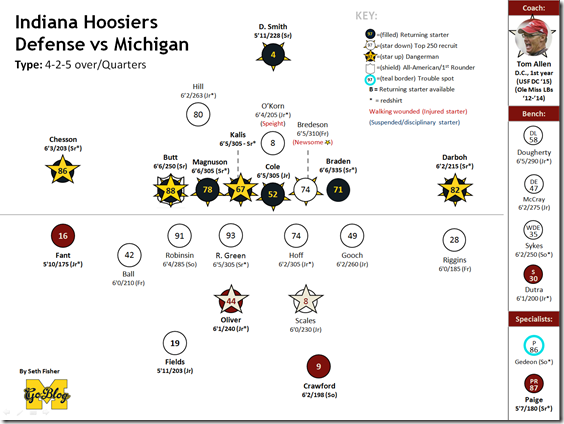
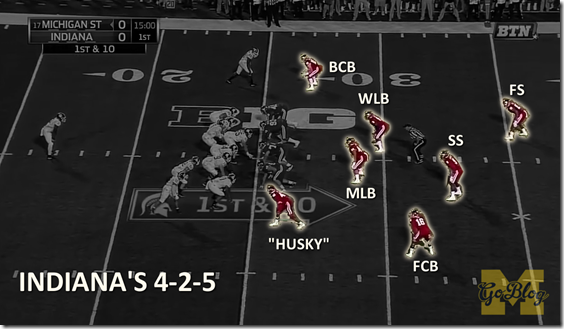
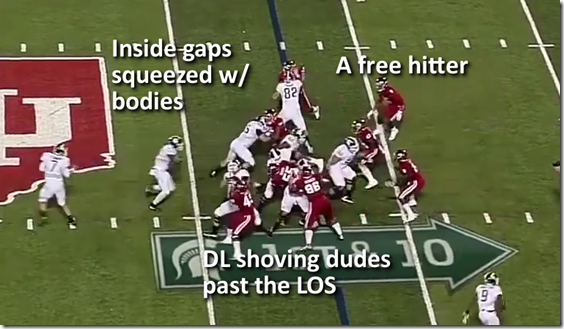
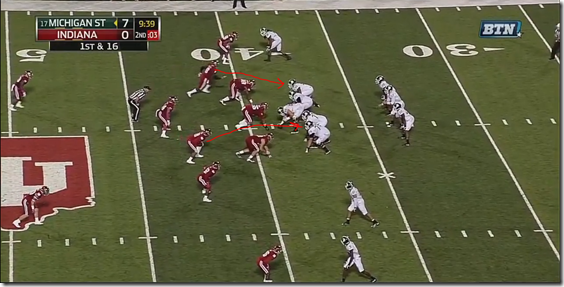
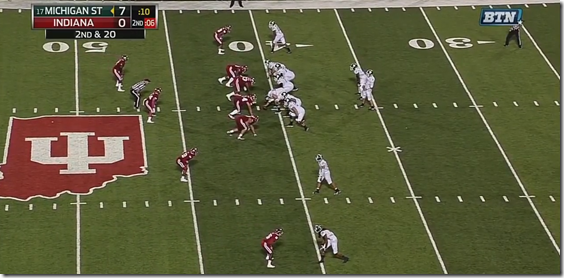


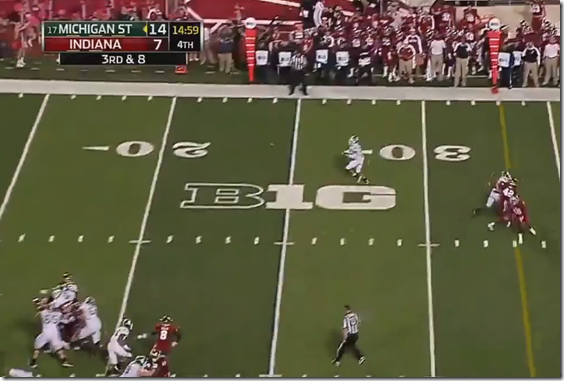

Comments